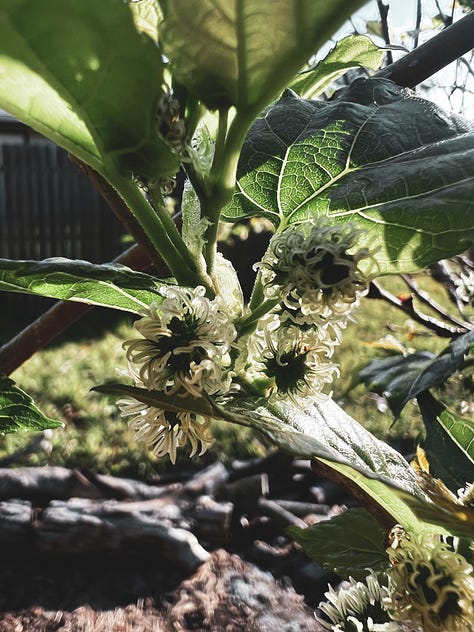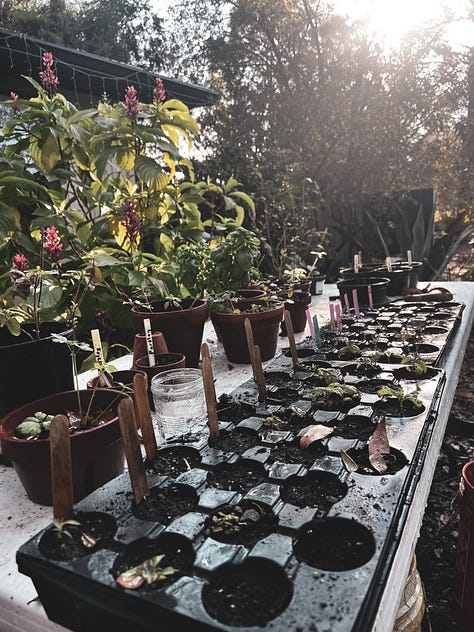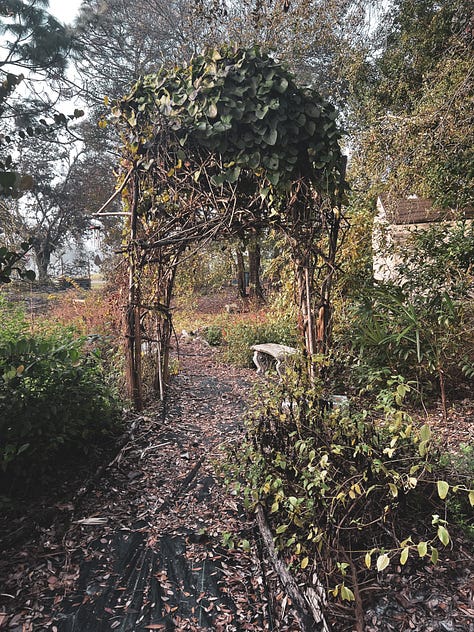The incredible response of resonance to my recent essay Villaging, Not Homesteading: We're Not Doing This Alone has made it clear: many of us long for a world of deeper interconnectedness and interdependence. We dream of shared resources, mutual care, and a sense of belonging that extends beyond the walls of our own homes. And yet, for so many of us, the simple act of stepping outside, walking over to a neighbor’s house, and knocking on the door feels nearly impossible.



The tension between wanting community and feeling unsure of how to create it is real. We hold back, unsure of whether our presence would be welcome. We hesitate, fearing awkwardness or rejection or differences between us that we cannot overcome. Perhaps we fear that something we’ll learn about a neighbor will make us feel even more alone or unsafe. So we stay indoors. We seek likeminded people on the internet. We talk about the need for third spaces and we dream of the world we want to live in. But we too often feel too frozen to do what lies before us to bring that world into form.
I say we, because this is me. I crave connection but am deeply accustomed to solitude. I generally prefer it. This is why The Art of Disappearing by Naomi Shihab Nye resonates so deeply with me:
When they say, "Don't I know you?" say no.
When they invite you to the party,
remember what parties are like
before answering.Someone telling you in a loud voice
they once wrote a poem.Greasy sausage balls on a paper plate.
Then reply.
If they say we should get together,
say why?It’s not that you don’t love them anymore.
You’re trying to remember something
too important to forget.Trees. The monastery bell at twilight.
Tell them you have a new project.It will never be finished.
This poem evokes the way I feel much of the time, and I know I am not alone in this. When I host meetings of the emerging neighborhood village co-op, one of the first things most of us say about ourselves is that we are introverted, that we are hermits. “I could spend weeks on end with a fridge full of groceries and a book and netflix and not see another soul and I wouldn’t mind,“ is a verbatim quote from our last meeting this past weekend. Many of us nodded in self-recognition. There’s almost a need to disclaim it, as if to explain why this kind of gathering is an anomaly for us. And yet, they show up. We show up.
Something in us longs for this—not the noisy, performative kind of socializing, but a quieter, more intentional way of being together. A way of being seen and known without being overwhelmed.
James Crews’ poem Neighbors speaks to another way of being that exists alongside Nye’s, a way of being that is what so many of us long for:
Where I’m from, people still wave
to each other, and if someone doesn’t,
you might say of her, She wouldn’t
wave at you to save her life—but you try anyway, give her a smile.
This is just one of the many ways
we take care of one another, say: I see you,
I feel you, I know you are real. I waveto Rick who picks up litter while walking
his black labs, Olive and Basil—
hauling donut boxes, cigarette packs
and countless beer cans out of the brushbeside the road. And I say hello
to Christy, who leaves almond croissants
in our mailbox and mason jars of fresh-
pressed apple cider on our side porch.I stop to check in on my mother-in-law—
more like a second mother—who buys us
toothpaste when it’s on sale, and calls
if an unfamiliar car is parked at our house.We are going to have to return to this
way of life, this giving without expectation,
this loving without conditions. We need
to stand eye to eye again, and keep asking—no matter how busy—How are you,
how’s your wife, how’s your knee?, making
this talk we insist on calling small,
though kindness is what keeps us alive.
The tension between these two poems speaks to the truth of where I live. It captures why I think it’s so important to take the first step, but not expect ourselves to do everything.
As I read these poems I sense that they’re pointing to the same thing, even if they seem at odds: they’re pointing to an attunement to awareness of the deeper tissues of the living world.
You’re trying to remember something
too important to forget.Trees. The monastery bell at twilight.
Tell them you have a new project.It will never be finished.
I see myself so completely in these lines. And for me, villaging is the remembrance of something too important to forget. And it is trees that we are tending and planting in our neighborhood. This deeper way of living is a new project. It will never be finished.
This is the essence of villaging: no one has to be the one who organizes the whole community. No one has to see it all the way through. But what we do have to do is show up, say hello, and be willing to connect.
What I have found is that by hosting a few initial gatherings and sharing a vision, the skills, gifts, passions, and connections of everyone involved begin to flow. The system begins to flow. People are introducing people to other neighbors, connecting the dots, and weaving the web of connection. There’s a lot of that going on that I don’t know about.
People are having conversations with one another that I don’t have to be a part of. Just yesterday I was thinking of what on earth to do with the dozens of squash plants that have spontaneously germinated from my compost recently. We don’t have the space or the sun for them. I googled some things and started imagining some of our neighbors who get way more sun than me building trellises, tunnels, all kinds of things where squash can grow. With the volume of little seedlings emerging right now, we could definitely have more than enough for the whole neighborhood for years if we distribute them and care for them just enough. I felt inspired and a little overwhelmed at this idea, and so I stepped outside to visit the little squash babies. Lo and behold, two of our neighbors who are the resident food-growing specialists here were just coming from a consultation with another neighbor a block over who is eager to do exactly that. The squash babes will find their home very soon.
People are collaborating and developing ideas for things they will create together, and I don’t need to be involved—but I will benefit because I live here. The genius of different people is coming forward in astonishing ways. We are all being pleasantly surprised, again and again, by the hidden talents and skills among us, and I don’t believe that any of us feel our solitude is being infringed upon, just enhanced.
The Gopher Tortoise
If you’re around me often enough, in person or online, eventually you’ll hear me talking about gopher tortoises. They’re big, beautiful keystone species that are critical in my home ecosystem here in the scrubland of Florida. They move slowly, live long lives, and dig deep burrows in the sandy soil, which provide shelter for more than 420 other species.
The way they provide habitat for so many other species is just by existing. Just by digging their own burrows. Just by living their lives, in their ecosystem, they benefit countless others, including all of us humans who live here, who depend on biodiversity in ways we will never fully understand.
Though gopher tortoises are primarily solitary, their burrows are often clustered near one another. Some tortoises visit particular burrows repeatedly, forming patterns of quiet companionship, especially the females who might go and visit one friend more often than others, even if others live closer to them. This reminds me of what’s happening among many of the women in my neighborhood. We each cherish our solitude, our self-sustaining little worlds, but more and more, we find ourselves wandering over to each other’s spaces, knocking on doors, going for walks, sharing tea.
Like the tortoises, we are creating a network—not through forced togetherness, but through gentle, chosen proximity. And as we make our homes and gardens more hospitable and fruitful for one another, we are also making them more welcoming to the broader web of life. What we build for ourselves inevitably becomes a refuge for others.
Not all solitude is isolation. Not all community is constantly social. The balance lives in the in-between.
I’d love to hear from you– how do you hold this tension? Where do you lie on the spectrum? What do you long for, and what feels like the next doable step for you to make it real? How can you begin where you are?





I had to join and subscribe now that you are bringing in gopher tortoises into the chat! So on our land here, we have a population of 40+ tortoises, and in many mystical ways, they are the deep reason we are here. I would love to connect more, I honestly feel the thread of the tortoises is like a key marker of how to build and weave connection and community in the south, and of course it's not on accident that they are a keystone species. The part of their magic I find so inspirational is how when the forest is on fire, that is when all the species band together--species that would traditionally not want to be so close, when the fires are raging, new alliances are built...and the peaceful, gentle nature of the tortoises, it's what makes it work. Anyway so much more to say... https://allyouneedinstitute.com/ is our current website, we also just started the non profit Burrow Nature Center